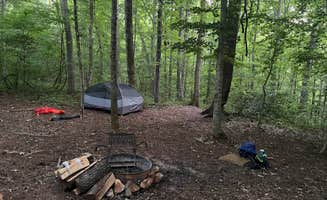Dispersed camping near McLeansville, North Carolina provides multiple backcountry options within the Piedmont region. The area sits at relatively low elevations of 500-700 feet above sea level, offering gentle terrain suitable for novice backpackers and tent campers. Most dispersed camping locations require permits or advance notice during hunting seasons, particularly from October through January when game management areas may have restricted access.
What to do
Trail exploration: The Birkhead Mountain Wilderness Area Dispersed offers nearly 6,000 acres of protected forest with multiple interconnecting trails. One visitor noted, "Very nice trails. Well maintained. Not marked the best... signs at intersections. Plenty of creeks. Hike in for dispersed camping."
Wildlife observation: Morning hours between 6-8 am provide optimal bird watching opportunities at Shallow Ford Natural Area. Campers often spot barred owls, pileated woodpeckers, and white-tailed deer. A recent camper shared, "This campsite is on the Mountains to Sea Trail for those that are doing that. There's lots of shade and it is very peaceful."
Water activities: Fishing for bass and bream is permitted at several creek access points within dispersed camping areas. Bring artificial lures rather than live bait to minimize environmental impact. Small inflatable watercraft can navigate portions of the waterways during spring high-water periods.
What campers like
Natural soundscapes: The ambient sounds of flowing water and forest wildlife create a peaceful atmosphere at Robbins Branch Trail. Many sites are positioned near small creeks, providing natural white noise that masks any distant road sounds.
Low light pollution: The distance from urban centers makes most McLeansville area dispersed sites excellent for stargazing. Clear nights reveal the Milky Way and meteor showers, particularly during winter months when foliage is reduced. Campers should bring red-filtered flashlights to preserve night vision.
Solitude opportunities: Many dispersed camping areas around McLeansville see minimal visitor traffic midweek, especially during shoulder seasons. Sites require at least a quarter-mile hike from trailheads, ensuring separation from other campers and reducing noise interference.
What you should know
Water source considerations: No drinking water is available at any dispersed camping sites near McLeansville. Campers must pack in all water or bring filtration systems for creek water, which can run low during summer months. Each person typically needs 2-3 liters per day.
Fire regulations: Most sites allow fires only within established rings when fire danger is low. During drought conditions or high fire danger periods, restrictions can be implemented with limited notice. Check with Guilford County forest service before departure.
Site access challenges: Many Birkhead Mountain Wilderness Area trails become muddy after rain, with some creek crossings becoming impassable following heavy precipitation. One visitor reported, "Not marked the best... signs at intersections." Plan extra travel time during wet conditions.
Tips for camping with families
Beginner-friendly options: First-time family backcountry campers should consider the more accessible sites at Shallow Ford Natural Area, where relatively flat terrain and short hiking distances accommodate younger children. Campsites are typically within a 1-mile hike from parking areas.
Wildlife education: Bring field guides specific to Piedmont North Carolina flora and fauna. Children can identify common species like eastern box turtles and red-tailed hawks. Morning is best for wildlife spotting when animals are most active.
Safety precautions: Shallow Ford Natural Area has uneven terrain and unmarked hazards near water edges. Families should establish clear boundaries for children and maintain a buddy system, especially near creek areas that can rise quickly after upstream rainfall.
Tips from RVers
Size restrictions: Most dispersed camping areas near McLeansville prohibit RVs due to access limitations and environmental impact concerns. Vehicle camping is limited to designated parking areas at trailheads, not within the dispersed camping zones themselves.
Nearby alternatives: RV campers seeking proximity to dispersed hiking can utilize established campgrounds within a 30-mile radius and make day trips to the natural areas. This strategy allows access to the same trail systems while maintaining necessary hookups.
Seasonal considerations: Road access to several trailheads becomes problematic for larger vehicles during winter months when unpaved surfaces may freeze or develop washouts. Call ranger stations for current road conditions before attempting access with any vehicle larger than a standard SUV.


